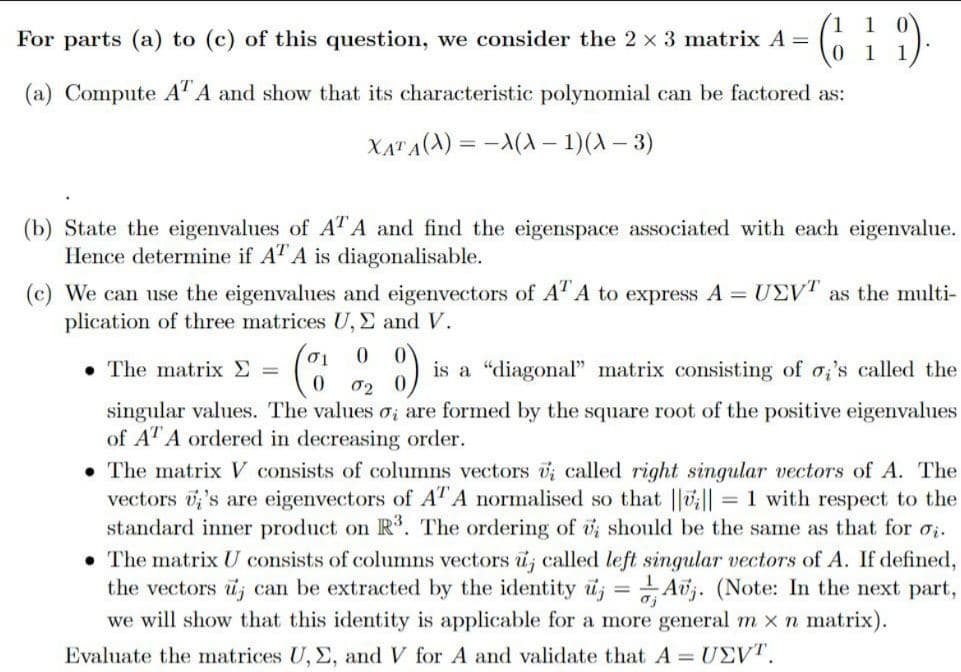For parts (a) to (c) of this question, we consider the 2 x 3 matrix A = (19) 01 (a) Compute AT A and show that its characteristic polynomial can be factored as: XATA(X) = X(X - 1)(x-3) (b) State the eigenvalues of ATA and find the eigenspace associated with each eigenvalue. Hence determine if AT A is diagonalisable. (c) We can use the eigenvalues and eigenvectors of ATA to express A = UEVT as the multi- plication of three matrices U, Σ and V. 0 The matrix > = 8) is a "diagonal" matrix consisting of o's called the 0 02 singular values. The values o, are formed by the square root of the positive eigenvalues of AT A ordered in decreasing order. The matrix V consists of columns vectors i called right singular vectors of A. The vectors 's are eigenvectors of AT A normalised so that ||||=1 with respect to the standard inner product on R3. The ordering of v; should be the same as that for ₂. . The matrix U consists of columns vectors u; called left singular vectors of A. If defined, the vectors u can be extracted by the identity uj Av. (Note: In the next part, we will show that this identity is applicable for a more general m x n matrix). Evaluate the matrices U, E, and V for A and validate that A = UEVT.
For parts (a) to (c) of this question, we consider the 2 x 3 matrix A = (19) 01 (a) Compute AT A and show that its characteristic polynomial can be factored as: XATA(X) = X(X - 1)(x-3) (b) State the eigenvalues of ATA and find the eigenspace associated with each eigenvalue. Hence determine if AT A is diagonalisable. (c) We can use the eigenvalues and eigenvectors of ATA to express A = UEVT as the multi- plication of three matrices U, Σ and V. 0 The matrix > = 8) is a "diagonal" matrix consisting of o's called the 0 02 singular values. The values o, are formed by the square root of the positive eigenvalues of AT A ordered in decreasing order. The matrix V consists of columns vectors i called right singular vectors of A. The vectors 's are eigenvectors of AT A normalised so that ||||=1 with respect to the standard inner product on R3. The ordering of v; should be the same as that for ₂. . The matrix U consists of columns vectors u; called left singular vectors of A. If defined, the vectors u can be extracted by the identity uj Av. (Note: In the next part, we will show that this identity is applicable for a more general m x n matrix). Evaluate the matrices U, E, and V for A and validate that A = UEVT.
Linear Algebra: A Modern Introduction
4th Edition
ISBN:9781285463247
Author:David Poole
Publisher:David Poole
Chapter4: Eigenvalues And Eigenvectors
Section4.3: Eigenvalues And Eigenvectors Of N X N Matrices
Problem 29EQ
Related questions
Question
part c

Transcribed Image Text:For parts (a) to (c) of this question, we consider the 2 x 3 matrix A = (19)
01
(a) Compute AT A and show that its characteristic polynomial can be factored as:
XATA(X) = X(X - 1)(x-3)
(b) State the eigenvalues of ATA and find the eigenspace associated with each eigenvalue.
Hence determine if AT A is diagonalisable.
(c) We can use the eigenvalues and eigenvectors of ATA to express A = UEVT as the multi-
plication of three matrices U, Σ and V.
0
The matrix > =
8) is a "diagonal" matrix consisting of o's called the
0 02
singular values. The values o, are formed by the square root of the positive eigenvalues
of AT A ordered in decreasing order.
The matrix V consists of columns vectors i called right singular vectors of A. The
vectors 's are eigenvectors of AT A normalised so that |||| = 1 with respect to the
standard inner product on R3. The ordering of v; should be the same as that for ₂.
• The matrix U consists of columns vectors u; called left singular vectors of A. If defined,
the vectors u can be extracted by the identity uj
Av. (Note: In the next part,
we will show that this identity is applicable for a more general m x n matrix).
Evaluate the matrices U, E, and V for A and validate that A = UEVT.
Expert Solution
This question has been solved!
Explore an expertly crafted, step-by-step solution for a thorough understanding of key concepts.
Step by step
Solved in 2 steps with 2 images

Recommended textbooks for you

Linear Algebra: A Modern Introduction
Algebra
ISBN:
9781285463247
Author:
David Poole
Publisher:
Cengage Learning

Elementary Linear Algebra (MindTap Course List)
Algebra
ISBN:
9781305658004
Author:
Ron Larson
Publisher:
Cengage Learning

Linear Algebra: A Modern Introduction
Algebra
ISBN:
9781285463247
Author:
David Poole
Publisher:
Cengage Learning

Elementary Linear Algebra (MindTap Course List)
Algebra
ISBN:
9781305658004
Author:
Ron Larson
Publisher:
Cengage Learning